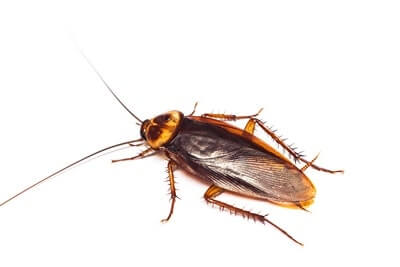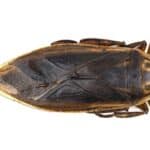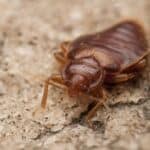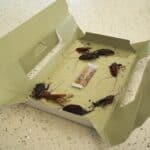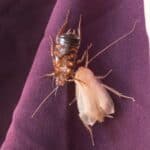It’s easy to mistake certain types of bugs for cockroaches. For example, many types of beetles have a similar appearance and movement patterns. Even some spiders can be confused with cockroaches.
Cockroaches can be mistaken for June bugs, Asian long-horned beetles, and water bugs. You may confuse crab spiders and tailless whip scorpions for a cockroach at a glance. Termites, crickets, and palmetto bugs are sometimes confused with cockroaches. When in the nymph stage, cockroaches look similar to adult bed bugs.
Look closely at the bug’s shape, coloring, and length of its antennae. Cockroaches have thin, long antennae that are shorter than the length of their body. They tend to be shades of red, black, or brown. Although cockroaches like water, they don’t live in water, and they’re not active fliers.
Are There Bugs That Resemble Cockroaches?
Many bugs look similar to cockroaches. In fact, some types of beetles may appear identical, especially if you only glance at them. Cockroaches and other insects may have the same:
- Coloring
- Patterns
- Body shape
- Movement style
- Size and dimensions
For that matter, they may even like the same habitats. Several kinds of insects like dark, isolated, warm, and slightly damp environments. That’s even true for some types of spiders, which you could mistake for cockroaches as you see them scurry across your wall.
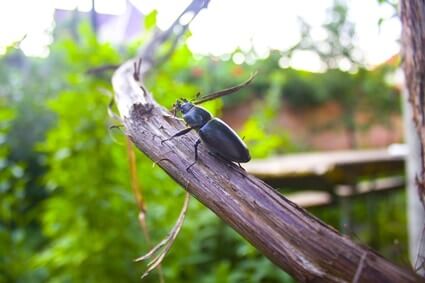
Beetles That Look Like Roaches
The most common insect mistaken for cockroaches is beetles. Beetles and cockroaches belong to the class Insecta, which is the entomological classification of insects. This means that they share similar characteristics. For example, both have an exoskeleton, wings, and mandibles. They may also have the same glossy bodies and a general shape.
Nonetheless, beetles and cockroaches belong to different entomological orders. These are Coleoptera and Blattodea, respectively. Beetles share this order with ladybugs and lightning bugs, while cockroaches share their order with termites. This is enough to create distinct differences between cockroaches and beetles, no matter the species.
Water Bugs
The term ‘water bug’ is a broad term. The most common bug found under this term refers to the giant water bug. ‘Giant water bug,’ in turn, can be used to refer to 170 species of bugs.
Even still, water bug often refers to different kinds of beetle and, mistakenly, cockroaches. This mainly applies to the Oriental cockroach. This species is commonly found living near sources of water, making the name appropriate.
Water Bugs Vs. Cockroaches
While beetles under the ‘water bug’ title can swim, roaches cannot swim. Cockroaches can live near water and enjoy damp areas, but they must live on dry land exclusively. Although they can hold their breath for long periods, cockroaches will eventually drown. True water bugs can live on the water.
True water bugs and cockroaches have similar appearances in terms of size and coloration. However, the primary difference between them is the habitats they choose.
Water bugs can be found in freshwater ponds, slow-flowing streams, and marshes. In contrast, cockroaches prefer to live in dry areas with rotting trees, leaf matter, and decaying food, with moisture on hand.
Water bugs in the beetle category measure smaller than most roach species, at around 0.8 inches long. However, some species are much larger than most cockroaches. Those from the genus Lethocerus come in at 4.5 inches.
Asian Long-Horned Beetles
The Asian long-horned beetle is an insect with distinct coloration. Because its markings are so unique, people often assume that it’s a cockroach and aim to remove it from their homes. However, this beetle will not cause any harm, at least not in your home.
The Asian long-horned beetle has a black body, with about 20 specks of white on its back, resembling a starry night. For this reason, this beetle is also called the sky beetle or starry sky beetle. While this is distinct from common pest species, this beetle is notably similar in appearance to the domino cockroach.
As its name implies, the Asian long-horned beetle is native to eastern China and Korea. However, according to the Annual Review of Entomology, it is considered an invasive species outside its native range. It can be found in Canada, France, Europe, and the U.S. In these areas, this beetle has been introduced accidentally, causing problems to the ecosystem.
Asian long-horned beetles infest trees, laying their eggs inside the bark and eating the wood. The beetle’s larva will also grow up to infest the same tree until the tree dies. The Asian long-horned beetle can cause the deaths of many trees, but they have also been known to infest warehouses that store wooden materials.
Asian Long-Horned Beetle Vs. Cockroaches
The Asian long-horned beetle is larger than household cockroaches. They measure about a ½ inch to 1.5 inches. They also have long antennae that are almost 2 inches longer than their body. Like some cockroaches, they can achieve flight for short periods of time.
This is a tree-infesting beetle, which is the best way to distinguish it from cockroaches. Many cockroach species can be found in wood, but they prefer other organic materials. They can also move to other habitats, like under rotting vegetation and shrubs. The Asian long-horned beetle will spend its whole life inside the tree that it infests.
June Bugs
June bugs, also known as may beetles, refer to about 300 species that belong to the beetle subfamily Melolonthinae. They have the same color range as cockroaches, with most June beetles having a reddish-brown appearance. However, just like roaches, these beetles can also be black in color.
June bugs are commonly spotted during the evenings, especially throughout spring. This is usually true for cockroaches, but they can be found at any time of the day. This is motivated by overcrowding in their nest or a lack of food. However, June bugs can’t be persuaded into moving around while the sun is out.
June bugs are also able to fly, just like some cockroach species. However, unlike cockroaches, June bugs are more active fliers. These beetles are much clumsier in flight and often fly into windows, clinging onto screens. Although some cockroaches can be spotted on windows, most tend to stay low and hidden.
June Bugs Vs. Cockroaches
June bugs are attracted to light, while cockroaches tend to scurry away from the light. That’s because it signals that a person is nearby. In contrast, June bugs will fly into light sources.
Aside from this, you can also distinguish a June bug from a cockroach based on its diet. June bugs will only eat leaves or other vegetation. Cockroaches can eat any organic matter but prefer rotting matter.
For physical differences, you can look at the insects’ backs. June bugs have a more circular and rounded body. Cockroaches are long and flat. Any width will always taper off on the bottom, making the cockroach more elongated.
June bugs are starkly different from cockroaches in terms of the shape of their antennae. June bugs have antennae that curl inwards. Roaches have antennae that are completely straight, thin, and much longer.
Spiders That Look Like Roaches
Spiders can bear a resemblance to cockroaches. That’s especially true for bulkier types of spiders.
Crab Spiders
Crab spiders often refer to the Thomisidae family of spiders, which includes over 2,100 species. These spiders are given their name because they resemble crabs, especially when they’re in a defensive position. These are a type of jumping spider. Instead of building webs to trap prey, they sit by flowers or fruit, grabbing insects that come nearby.
Crab Spiders Vs. Cockroaches
Some types of crab spiders share a habitat preference with cockroaches. They can be found in the spaces inside tree trunks, hiding under loose bark, or hunting in leaf matter.
Crab spiders also bear a close resemblance to small cockroaches, especially when they’re not moving. The spiders tuck their legs under their body, just like a crab. With their distinctive legs hidden, their main body can look like a cockroach at first glance.
However, these spiders will be much smaller than most roach species. They measure in at less than half an inch. Crab spiders of the family Thomisidae are not harmful to humans, as they only eat insects. They don’t bite and aren’t venomous.
Tailless Whip Scorpion
The tailless whip scorpion looks like whip scorpions, but this arachnid does not have a telson or tail. Because of that, you may think it’s a roach at first glance.
There are about 70 species of this arachnid, measuring about a ½ inch to almost 2 inches. Technically, tailless whip scorpions are not spiders. However, they do belong to the class Arachnida, which spiders are a member of.
You can find this arachnid in hot areas of North and South America. Tailless whip scorpions are easy to distinguish from cockroaches, especially those that are larger in size. However, smaller species can be mistaken for cockroaches due to their coloring and body shape.
Tailless Whip Scorpions Vs Cockroaches
Smaller tailless whip scorpions look similar to cockroaches with long, flat bodies. However, if you look closely, there are important distinctions to be made.
The arachnid has an elongated body, but it is split into two joined parts. The head area of the scorpion is more circular, while the joined back area is more of an oblong.
The legs of these insects are similar in structure, but those of the tailless whip scorpion are much longer. Both tailless whip scorpions and cockroaches have mandibles, although the scorpion has a pair of large pinches in front of it.
Other Insects That Resemble Cockroaches
There are 30 orders of insects, and not all of them have unique shapes and sizes. Because of this, you may mistake these common bugs with cockroaches.
That’s made worse by the fact that cockroaches share similar behaviors with many other insect species. To enable you to tell them apart, here are the key differences:
Termites
You may confuse cockroaches and termites. Their appearances are more distinct from one another, but these two insects are closely related. According to Biology Letters, both belong to the order Blattodea.
However, the behavior of termites and roaches is very different. Termites live in colonies with a highly organized social structure. Each bug has its own role, and each colony is complete with a king and queen.
Cockroaches lack a social hierarchy. While they make decisions collectively, there are no clearly defined roles between members, and there are no social structures.
Termites form colonies that can range in number from 60,000 to a million. In contrast, cockroaches live in much smaller numbers. In fact, they are inclined to break apart into smaller, equally numbered groups if their living space won’t fit the whole colony.
Cockroaches Vs. Termites
Roaches and termites have different preferences for their habitats. Termites infesting a home prefer to live inside the walls, feeding on wood. Cockroaches are less commonly found in walls. They will live anywhere that they can gain entry, but this is usually in closets, behind appliances, or in other hidden corners.
The two insects also differ when it comes to diet. Termites prefer to live inside walls because they only feed on wood. Cockroaches are omnivorous scavengers, so they eat pretty much any organic material in your home.
Physically, termites are smaller than most cockroaches, measuring about a ¼ to a ½ inch long. Termites are also soft-bodied, making their appearance much glossier than cockroaches.
While they share some colors, termites are on the lighter end of the spectrum. At their darkest, they’re a light shade of brown. They may even appear white. Cockroaches are only white after a molt and usually come in dark brown shades.
Bed Bugs
Bed bugs are often mistaken for cockroach nymphs. They are similar in appearance, especially with the nymphs of the German cockroach.
Because of their size, it can be hard to determine whether an insect is a bed bug or a cockroach nymph. Adult bed bugs often appear flat in shape, measuring about the size of an apple seed. However, after feeding, they swell up to be round and turn red. This makes them appear similar to cockroach nymphs.
Bed Bugs Vs Cockroaches
To distinguish one from the other, you’ll need to collect the insects. Because their sizing is almost identical, you’ll need to examine the body shape of the bed bug or nymph.
Bed bugs are rounder, while nymphs tend to be more oval or rectangular. Bed bugs are also reddish, compared to the brown or tan of a baby German roach.
Crickets
Crickets are one of the most common insects mistaken for cockroaches. Like cockroaches, crickets also come in a wide range of sizes and colors. When outdoors, cockroaches and crickets are even found in similar habitats. Wild species of cockroach can also produce a sound that’s easy to mistake for a cricket’s chirp.
Crickets Vs Cockroaches
Crickets are often darker in color than cockroaches. They range from dark yellow to tan to black. Cockroaches can be found in these colors, but they’re also found in redder shades.
Another distinction is the large hind legs that crickets have. These legs are used for jumping, which accounts for their size. While cockroaches can jump, their legs are not purposefully designed for this. They are instead lean and thin, and any leaps require the use of their wings.
Both insects can be found in the same outdoor areas, but only cockroaches tend to invade homes. Should crickets ever find their way inside, they’ll likely be near entrances, like porches. The presence of plants and vegetation will also make crickets more likely.
Perhaps the easiest way to distinguish crickets from cockroaches is their reaction to being spotted. Roaches scurry and hide when they’re in the presence of others. The extent of this can vary from one species to another, but this behavior remains consistent for all household species.
Crickets will use their powerful hind legs to propel themselves away from you. This jump allows them to cover a large area, making their escape swift and effective.
Palmetto Bug
The term ‘palmetto bug’ doesn’t refer to one insect. Instead, it’s a term used for many different species. The most common include different species of beetles. It can also refer to bugs that resemble cockroaches and beetles, as well as insects that share the behaviors and habitat of those species.
The name is taken from the palmetto plant, which grows in the southeastern parts of the U.S. This is a tropical plant with large, fan-like leaves. Insects referred to as palmetto bugs are often the bugs that live under the shade of this plant.
However, palmetto bugs aren’t limited to just those that live under palmetto plants. These bugs can also live under trees and dense shrubbery, which provide shade similar to that of the palmetto plant.
The term ‘palmetto bug’ can be used to refer to beetles, but it’s also used to refer to cockroaches, such as the:
- Florida wood roach
- American cockroach
- Smoky brown cockroach
Specifically, these roaches will be found living in the soil. If you think you’ve spotted a palmetto bug, check closer to see if it’s indeed a palmetto bug roach or a palmetto bug beetle.
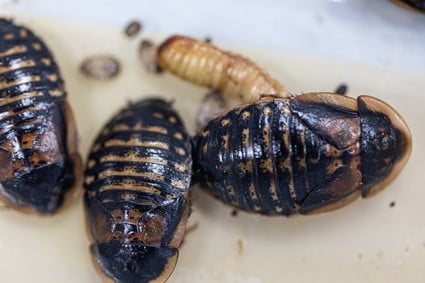
How To Tell If A Bug Is A Roach
Some characteristics are unique to cockroaches. These apply no matter what species the cockroach belongs to.
Size
Cockroaches vary in size, with fully-grown adults ranging from a ½ inch to nearly 3 inches in length. However, the most common pest species, like the American cockroach, often average about 1.5 to 2 inches in length.
This size doesn’t include the antennae. Even still, the length and shape of the antennae can be useful in distinguishing cockroaches from other insects.
Shape
Each cockroach species has a slightly different body type. Some are rounder, while others are more elongated. Some are wider near the head, while others are wider near the bottom. All cockroach species are long, flat, and slightly oval-shaped. There is no cockroach that’s completely round.
Color
For cockroaches, colors can vary from red to brown to black. Nymphs will be white after molting, as their exoskeletons are still hardening. This color will be a slightly opaque, milky white. As the skeleton hardens, the color of the nymph returns to brown, black, or red.
Keep in mind that molting is a common occurrence among other insect nymphs. While not all insects do it, it’s not a unique behavior to cockroaches. If you notice a white bug, look closely for other identifying features.
Diet
One of the differences between roaches and other insects is their diet. Cockroaches are one of few scavengers in the order of insects. All other scavenger species, like the blowfly and Australian desert ant, look different from cockroaches. The only exception is members of the scavenger beetle, although these cannot be found in human homes.
In fact, cockroaches are the only scavenger insects that are considered pests. All other kinds will not infest your home, nor will they have any preference for invading the indoors. Instead, these species will happily live:
- Out on forest floors
- Buried under soil
- Near water sources
Not all bugs are harmful. Once you can tell the difference between cockroaches and bugs, you can avoid a lot of unnecessary concerns.
